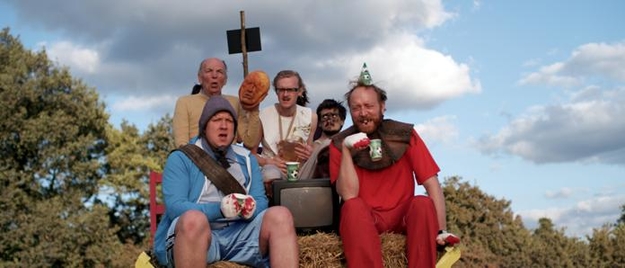Taking their cue from SMART Project Space’s historical function as a morgue, Mellors and Bloor will take you on an excursion inside an imaginary body, creating a narrative framework where each exhibition space is mapped to a specific body part:
- Entrance/ Right Eye (technical) - Vito Acconci; Paul Laffoley; spiritualist works from the Harry Price Archive; Nathaniel Mellors; Chris Bloor
- The Brain - Ourhouse: 'The Cure of Folly', newly commissioned scenes from Mellors Ourhouse series; Pieter van der Heyden
- The Mouth - Linda Quinlan
- Left Eye (visionary): Basil Wolverton; Robert Abel; Chicago Imagists Karl Wirsum and Gladys Nilsson; Bob Parks; Brian Catling; Paul Laffoley; Mick Peter; Chris Bloor
- Genitals / Toitlet Area: Tala Madani; Timmy van Zoelen; Chris Bloor; Vito Acconci
- Foot: Erkka Nissinen; James Gilray; Mellors & Bloor
- Upper Guts: Mick Peter; Linda Quinlan; James Ensor
- Lower Guts / Exit: Timmy van Zoelen; Nathaniel Mellors
Key to the exhibition is the brain room where the new film commission Ourhouse Episode 3 ‘The Cure of Folly’ or ‘De Keisnijder’ is shown. Recently co-produced by SMART Project Space and Nomad (UK), it is part of an episodic series of films written and directed by Mellors. On this occasion ’Ourhouse’ (the eponymous family home) is under attack from a carnivalesque medieval procession featuring a disconsolate, self-harming male gang (Roger Sloman, Christos Lawton and Ryan Ellsworth), who are appropriated by a powerful female mystic known as ‘The Hek’ (Honeysuckle Weeks); this group of revellers ride on a haywain towards the house in pursuit of “the stone of madness”. This occurrence is the result of ‘The Object’s’ ingestion of some books on Flemish painting – specifically two paintings by Hieronymus Bosch - The Haywain Triptych (1490) and Cutting the Stone or Extraction of the Stone of Madness (1494), as well as various etchings after Bosch on the same theme, such as De Keisnijder (de heks van Mallegem, 1559) by Pieter van der Heyden. As in previous episodes the script combines linguistic and visual absurdism and returns to Mellors recurrent theme of power and control through the manipulation of language.
A substantial portion of the exhibition is devoted to the diverse & dynamic exchange that Mellors shares with artistic contemporaries such as Vito Acconci, Brian Catling, Chris Bloor, Mick Peter & Erkka Nissinen, as well as with a younger generation of artists including Tala Madani, Linda Quinlan and Timmy Van Zoelen —all of whom, like Mellors, developed deliberately coarse styles and make liberal use of satire and caricatural line to speak of broad social inequities and expose more specifically the ineptness of power relations. With specific inclusion of the Belgian artist James Ensor, underpinning Fin-de-siècle and early twentieth-century avant-garde circles, the subversion of the authority of artistic tradition through the cultivation of one’s individual style was understood as a powerful weapon for social change. There are also a number of historical and archival ‘visionary’ works within the exhibitions, including a laser-disc showreel by visual effects innovator Robert Abel, photographs from the Harry Price Archive and prints by James Gillray, Pieter van der Heyden, William Hogarth and Ambroise Paré.
As with many of his earlier works, Mellors draws upon a broad range of artistic, literary, film, and philosophical sources, from a sharp send-up of authoritarian hubris - the etching Doctrinal Nourishment (1889/95) is one of Ensor's most politically scathing works in which bloated, self-satisfied, bare-bottomed public officials excrete a foul diet literally to be swallowed by the masses - Acconci’s video work Face-Off (1972) is an ironic collusion of private and public, of exposure and masking, a tense ritual wherein Acconci divulges and then censors his self-revelations, to the demented materiality of Basil Wolverton’s drawings. What these varied works share is a common political context: an immersion into grotesque and absurd imagery through which to expose the incompetence of unchecked authority that is indicative of a society in crisis.
Opening
3 September 2011, 7 pm
